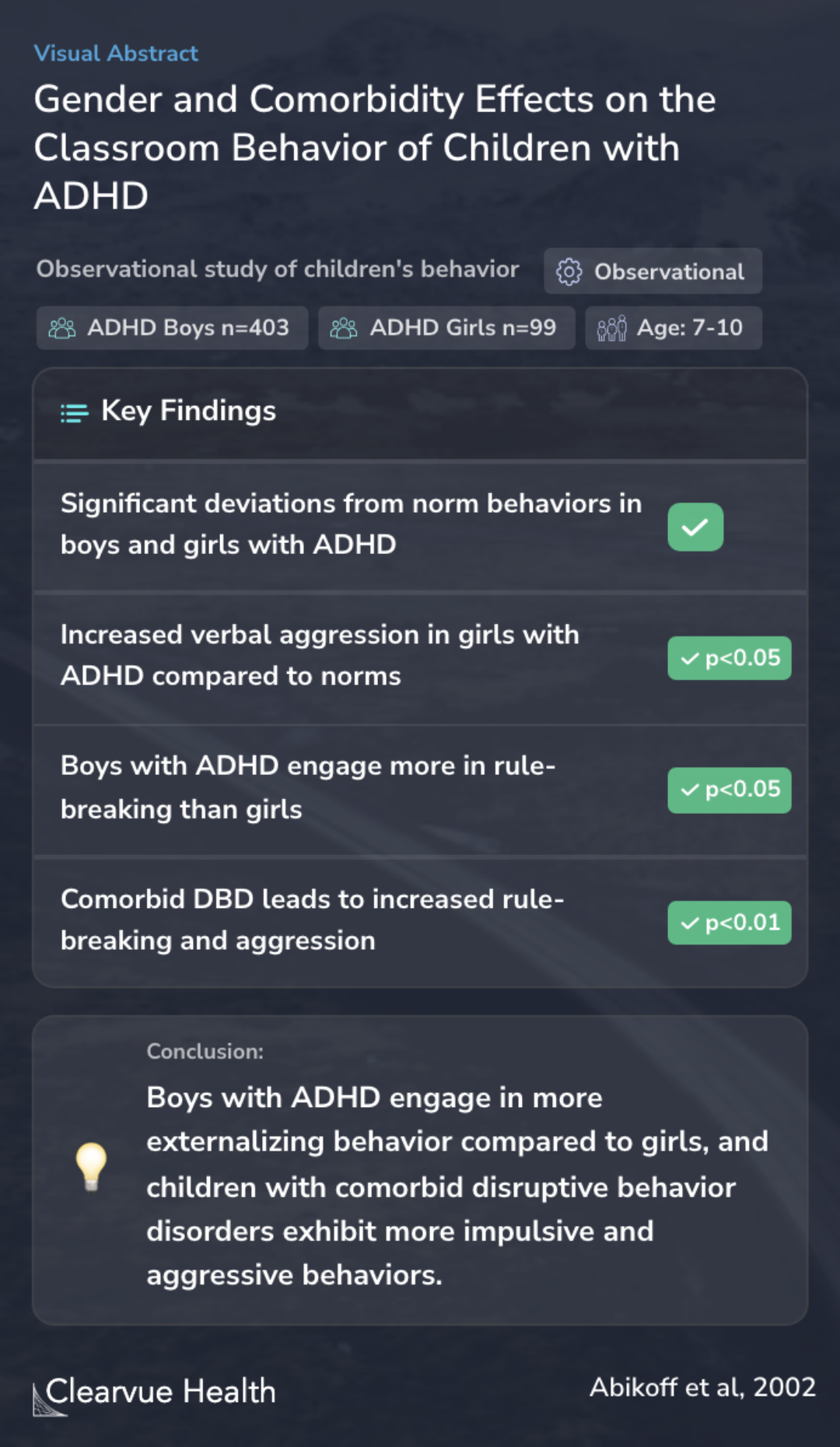Observed classroom behavior of children with ADHD: relationship to gender and comorbidity
Gender and Comorbidity Effects on the Classroom Behavior of Children with ADHD
Abikoff HB, Jensen PS, Arnold LL, Hoza B, Hechtman L, Pollack S, Martin D, Alvir J, March JS, Hinshaw S, Vitiello B, Newcorn J, Greiner A, Cantwell DP, Conners CK, Elliott G, Greenhill LL, Kraemer H, Pelham WE, Severe JB, Swanson JM, Wells K, Wigal T

Objectives
The study focused on exploring whether there are differences in classroom behavior between boys and girls with attention deficit hyperactivity disorder (ADHD), and how these behaviors might vary when other disorders are also present. The researchers aimed to understand if these differences could explain why girls with ADHD are often identified and get help later than boys.
Examined hypothesized gender and comorbidity differences in the observed classroom behavior of children with attention deficit hyperactivity disorder (ADHD).
Methods
In the study, the behaviors of 403 boys and 99 girls with ADHD, all between the ages of 7 to 10, were carefully observed and recorded. These observations were then compared to what is typically expected of boys and girls at this age in a classroom setting. The study also looked at how these behaviors changed if the children had other disorders along with ADHD.
The behavior of 403 boys and 99 girls with ADHD, ages 7-10, was compared (a) to observed, sex-specific classroom behavior norms, (b) by sex, and (c) by comorbid subgroups.
Results
The findings showed that both boys and girls with ADHD acted differently from their peers in most behavior categories studied. Specifically, girls with ADHD showed higher levels of verbal aggression compared to other girls, and boys with ADHD broke rules more frequently than girls. Interestingly, having an additional disorder like disruptive behavior disorder (DBD) led to even more challenging behaviors, disproving the idea that other disorders might lessen the ADHD symptoms. These results highlight how ADHD affects children's behavior in school and the impact of additional disorders on these behaviors.
Boys and girls with ADHD deviated significantly from classroom norms on 15/16 and 13/16 categories, respectively. Compared to comparison girls, girls with ADHD had relatively high rates of verbal aggression to children. Boys with ADHD engaged in more rule-breaking and externalizing behav...
Conclusions
The study concludes that boys with ADHD generally show more behavior problems like rule-breaking and aggression compared to girls. When ADHD is combined with other disorders, kids tend to act out even more.
The sex differences in the classroom behaviors of children with ADHD may contribute to the later identification and referral of girls with ADHD. The presence of comorbid disorders, particularly DBD, influences the type and frequency of behavioral issues observed in children with ADHD, ch...
Evidence Comparison
The guidelines from the AAP and CDC advocate for a mix of medication and behavioral therapies to manage ADHD, reflecting the necessity of a comprehensive approach across different age groups. For preschool-aged children, Parent Training in Behavior Management (PTBM) is emphasized as essential, aligning with the importance of early intervention in managing disruptive behaviors noted in the study. This approach extends to school-aged children and adolescents, where a combination of FDA-approved medications, PTBM, and educational supports like 504 plans and Individualized Education Programs (IEPs) are recommended. The paper's findings on the need for tailored behavioral interventions and the critical management of comorbid conditions such as anxiety and depression corroborate these strategies, underscoring the complexity of treating ADHD with co-existing disorders.
Key Takeaways
More Articles
For those intrigued by the multifaceted nature of ADHD treatment and management, further exploration into related areas is available. One particularly relevant article examines the link between ADHD symptoms and risky sexual behaviors in adolescents, highlighting the mediation role of conduct problems and substance use. This study suggests that addressing underlying issues like marijuana and alcohol use could significantly impact behavioral outcomes for teenagers with ADHD.
Another compelling read focuses on the effectiveness of parent training in managing ADHD symptoms and behavioral issues in children. This research emphasizes that parental involvement and specific training programs are highly effective in improving children's behavior and emotional challenges, providing practical insights into daily management strategies for families dealing with ADHD.